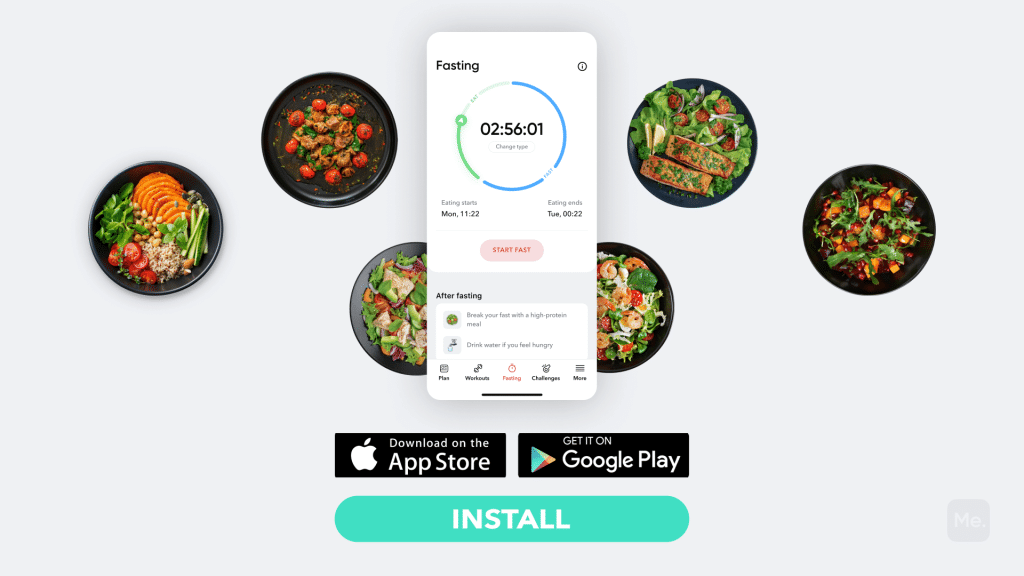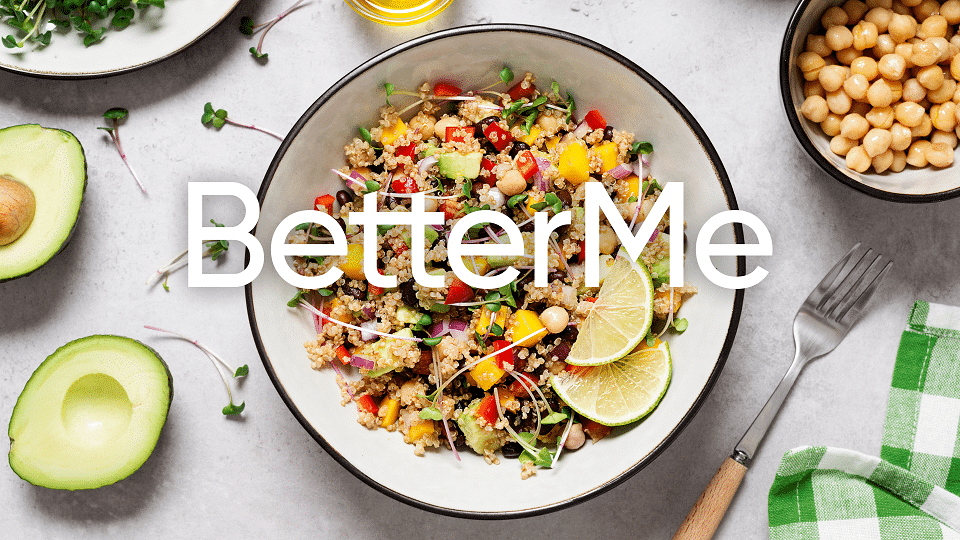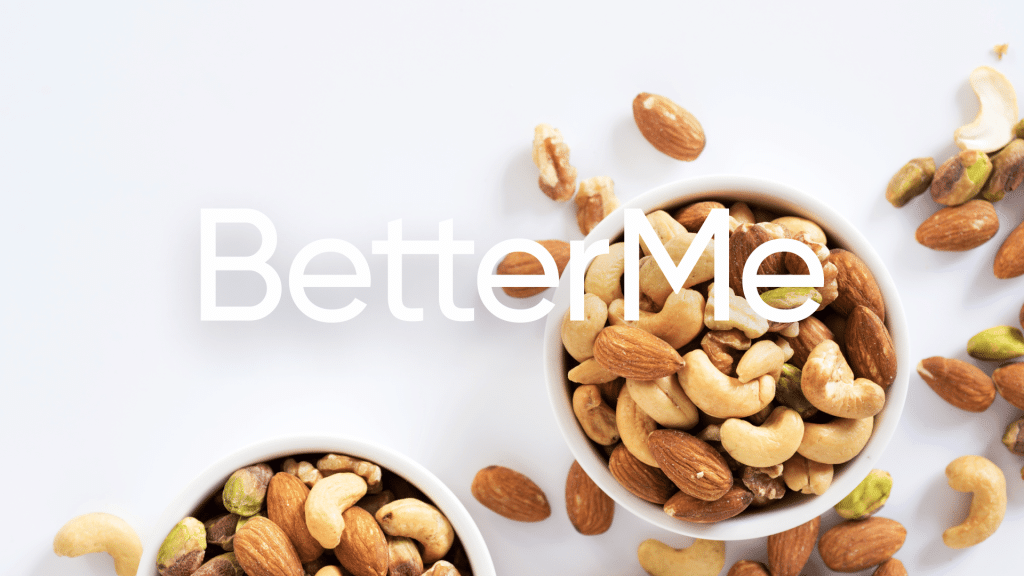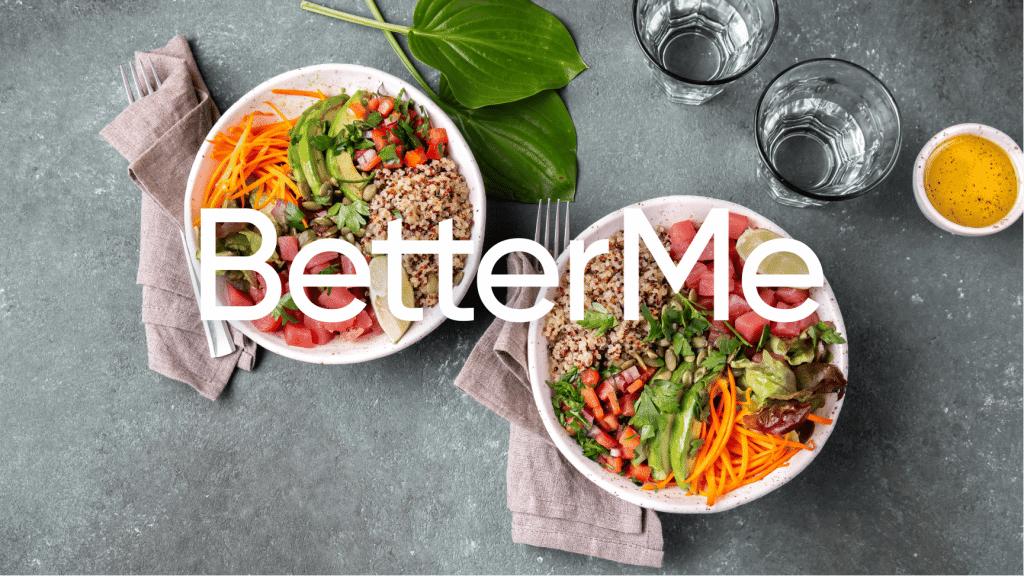If you’re like most people with a day job, you’re probably always on the go and don’t have a lot of time to cook. Add a health-conscious diet to the mix, and it can seem impossible to eat healthy. Let’s say you’re onto meal-prepping: making big batches of food on the weekends to eat throughout the week. But sometimes, even that can get old. Who wants to eat the same thing day after day? Enter roasted veggie bowls. These bowls are packed with nutrients, easy to make ahead of time, and best of all, they’re delicious. Plus, they’re versatile: you can mix and match different veggies, grains, and proteins to suit your taste. In this article we’ll explore the health benefits of roasted veggie bowls and give you some tips on how to make them. By the end you’ll be a roasted veggie bowl pro!
Get your personalized
meal plan!
What’s In A Roasted Veggie Bowl?
Colorful, nutritious, and filling, roasted veggie bowls are a complete meal in one. They typically include a mix of roasted vegetables, a grain or starch, and a protein.
The ingredients can be as simple or complex as you like, but we recommend using a mix of fresh and roasted veggies for the best flavor and texture. Vegan, vegetarian, or meat-eater? No problem! Roasted veggie bowls can be tailored to any diet.
Below are our top picks for roasted veggie bowl ingredients:
Rainbow Colored Veggies
The main, and usually the largest, component of roasted veggie bowls are the vegetables.
We like to use a mix of different colors and textures for a well-rounded bowl. Not only does this make the bowls more visually appealing, but it also ensures you’re getting a good mix of nutrients.
Some colors and their accompanying nutrients include:
Red (Lycopene): Tomatoes, red cabbage, rutabagas, carrots
Lycopene is a red pigment that is found in plants and fruits, and is responsible for the red color of tomatoes. Like other antioxidants, it may help reduce the risk of several diseases, including cancer, heart disease, and macular degeneration. Lycopene is also thought to boost the immune system and protect against sun damage (2).
Purple/Blue (Anthocyanins): Purple potatoes, eggplant, purple cabbage, kale, asparagus, turnips, beets
Anthocyanins are a type of flavonoid, which are plant compounds that have many health benefits. They are thought to protect against chronic diseases like cancer and heart disease, as well as improve cognitive function and memory (2).
Orange/Yellow (Vitamin C, Carotenoids): Carrots, sweet potatoes, squash, pumpkin, corn, yellow peppers
Vitamin C is a water-soluble vitamin that is involved in many processes in the body, including the formation of collagen, absorption of iron, and the maintenance of immune function. It is also an antioxidant, meaning it helps to protect cells from damage (2).
Carotenoids are a type of pigment found in plants, and they’re what give these fruits and vegetables their orange and yellow color. Like vitamin C, they are also antioxidants with many health benefits and beta carotene, for example, is an important precursor to vitamin A (2).
Green (Vitamin A, Vitamin K, Vitamin C, Lutein, Zeaxanthin): Green beans, broccoli, Brussel sprouts, spinach, peas, asparagus, sprouts, collard greens, bok choy, kale, avocado
Whether you’re a workout beast or just a beginner making your first foray into the world of fitness and dieting – BetterMe has a lot to offer to both newbies and experts! Install the app and experience the versatility first-hand!
Green vegetables are loaded with vitamins and minerals. Vitamin A is important for vision, skin health, and immunity. Vitamin K is necessary for blood clotting and bone health (6).
As we mentioned before, vitamin C is an important antioxidant involved in many processes in the body. Lutein and zeaxanthin are two more antioxidants found in green veggies that are important for eye health (6).
White/Brown (Allicin): Garlic, onion, mushrooms, cauliflower, jicama, daikon radish, turnips
Allicin is a compound found in garlic and onions with many possible health benefits. It is thought to support the immune system, protect against heart disease and cancer, and improve gut health. Allicin is also a natural antibiotic and antifungal agent (4).
Whole Grains/Pseudo-Grains
Another key ingredient in roasted veggie bowls are whole grains or pseudo-grains. These provide complex carbs, fiber, and a range of vitamins and minerals. They also help to bulk up the bowls and make them more filling.
Some of our favorite whole grains and pseudo-grains include:
- Quinoa
- Brown rice
- Farro
- Barley
- Buckwheat
- Amaranth
- Millet
Protein
Protein is an important nutrient that helps to build and repair tissues, as well as produce enzymes and hormones. It is also essential for the growth and maintenance of muscle mass (7).
For roasted veggie bowls, we like to use plant-based proteins like tofu, tempeh, and beans. However, you could also use animal protein like chicken, fish, or beef.
Many people don’t realize that veggies too contain protein. For example, 1 cup of cooked broccoli has about 4 grams of protein (3). Even if you’re not adding an extra source of protein to your bowl, you’re still getting some from the veggies.
Read More: Hearty Salmon Salad Recipe
Healthy Fats
Healthy fats are an important part of a balanced diet. They help to absorb fat-soluble vitamins, support cell growth, and protect the body’s organs. They also help to keep us feeling full and satisfied after eating (1).
Some healthy fats to include in roasted veggie bowls are:
- Extra virgin olive oil
- Nuts and seeds
- Avocados
- Coconut oil
- Full fat yogurt
Roasted Veggies Recipe
Now that you know what goes into roasted veggie bowls, let’s get to the recipes. Below are a few of our favorites.
30-Minute Roasted Rainbow Vegetable Bowl (8)
This recipe by the Minimalist Baker is perfect for busy people who want to eat healthy. It includes a mix of colorful roasted veggies and a tasty tahini dressing. It can be made in just 30 minutes, and it’s vegan and gluten-free.
Ingredients:
Vegetables
- 3-4 medium red or yellow baby potatoes (sliced into 1/4-inch rounds)
- 1/2 large sweet potato (skin on, sliced into 1/4-inch rounds)
- 2 large carrots (halved and thinly sliced)
- 1 medium beet (sliced into 1/8-inch rounds)
- 4 medium radishes (halved, or quartered if large)
- 2 tbsp avocado or melted coconut oil (divided if oil-free, sub water or vegetable broth)
- 1 tsp curry powder (divided)
- 1/2 tsp sea salt (divided)
- 1 cup cabbage (thinly sliced)
- 1 medium red pepper (thinly sliced)
- 1 cup broccolini (roughly chopped)
- 2 cups chopped collard greens or kale (organic when possible)
Toppings
- 1 medium lemon (juiced, ~3 tbsp or 45 ml as original recipe is written, divided)
- 2 Tbsp tahini (divided)
- 2 Tbsp hemp seeds (divided)
- 1/2 medium avocado (divided, optional)
Dropping pounds by the dozens without putting yourself through the wringer is everyone’s weight loss pipe dream. But what if we told you that the BetterMe app can make that happen? Keep yourself in prime shape with our fat-blasting workouts, delicious budget-sparing recipes, and body-transforming challenges with our app!
Instructions:
- Preheat the oven to 375 degrees F (190 C) and line a baking sheet with parchment paper.
- Slice your hard vegetables first: potatoes, sweet potatoes, carrots, beets and radishes. These take the longest to roast, so we’ll get them in the oven first.
- Add these sliced vegetables to a large mixing bowl with half of the oil (or water), curry powder, and sea salt (as original recipe is written- 1 Tbsp (15 ml) oil (or water), 1/2 tsp curry powder, and 1/4 tsp sea salt).
- Toss well to coat. Then spread them in an even layer on the baking sheet.
- Roast for 20-25 minutes, stirring a few times throughout, until fork-tender and slightly browned around the edges.
- Meanwhile, prepare the rest of your veggies: cabbage, red pepper, broccolini and greens. Season with the remaining oil (or water), curry powder and sea salt.
- Once the hard veggies have roasted for 10 minutes, add the remaining veggies to the baking sheet and stir everything around to mix.
- Roast for an additional 10-15 minutes, until all vegetables are fork-tender and slightly browned around the edges.
- Remove from oven and let cool briefly.
- To a small bowl, add half of the lemon juice, tahini, hemp seeds and avocado (optional). Mix well.
- Serve roasted vegetables warm or cold, topped with the tahini sauce, fresh herbs and any other desired toppings.
This recipe is courtesy of minimalistbaker.com
Roasted Veggie Bowl With Turmeric Dressing (9)
If you’re in the mood for a more filling bowl with a bit more protein, this recipe from Our Balanced Bowl is for you. With quinoa, roasted sweet potatoes, and a flavorful turmeric dressing, it will leave you feeling satisfied and energized.
Ingredients:
- 2 medium sweet potatoes, diced into small chunks
- 2 small heads of broccoli, diced
- Salt, pepper and garlic powder to taste
- 1/2 cup quinoa
- 1 cup water
- 1 tbsp oil of choice (I used avocado)
Read More: Energy Balls: The Best Ingredients To Beat The Midday Energy Slump
For the Turmeric Dressing
- 1/4 cup tahini
- 1/2 tsp ground turmeric
- juice of 1 lemon
- 2 minced garlic cloves
- 1/4 tsp ground ginger
- 1 tbsp avocado oil
- 2 tbsps water
- 1 tsp apple cider vinegar
- Salt and pepper to taste
- 1/4 tsp cayenne (optional)
Instructions:
- Preheat the oven to 375 degrees Fahrenheit and line a baking sheet with parchment paper.
- Wash and slice all vegetables. Spread them on the baking sheet. Season with salt, pepper and garlic powder, to taste.
- Bake for 20-25 minutes, stirring a few times, until fork-tender.
- While vegetables are roasting, cook quinoa according to package instructions. Season with salt, pepper and garlic powder, to taste.
- Once vegetables and quinoa are cooked, begin preparing the dressing. Simply combine all ingredients in a high-speed blender or food processor and blend until smooth.
- Assemble bowls by adding quinoa and roasted vegetables to a bowl. Drizzle with turmeric dressing and enjoy!
This recipe is courtesy of ourbalancedbowl.com
Roasted Veggie Bowls Health Benefits
There are so many reasons to love roasted vegetable bowls! Below are some of the top potential health benefits of eating roasted vegetables:
Improved Gut Health
Your gut is home to trillions of bacteria, which play an important role in everything from your immune system to your mood. Eating a diet rich in vegetables helps keep your gut healthy by providing prebiotic fiber, which feeds the good bacteria in your gut (5).
Lower Risk Of Disease
The Standard American Diet (SAD) is high in ultra processed foods, sugar, and unhealthy fats, and low in nutrient-rich whole foods. This diet has been linked to an increased risk of chronic diseases like heart disease, cancer, and type 2 diabetes (10).
Eating a diet rich in vegetables, on the other hand, has been shown to protect against these chronic diseases. This is likely due to the fact that vegetables are packed with fiber, antioxidants and other nutrients that may help to reduce inflammation in the body (5).
Weight Loss
If you’re trying to lose weight, adding more vegetables to your diet is a great place to start. This is because vegetables are low in calories but high in fiber, which helps to keep you feeling full and satisfied after eating (5).
Roasting is a low-calorie cooking method that is comparable to frying or sautéing, and can help you lose weight or maintain a healthy weight.
Improved Digestion
Vegetables are a great source of fiber, which is important for promoting regularity and preventing constipation. Fiber adds bulk to your stool and helps it move through your digestive tract more easily (5).
In addition, fiber-rich foods like vegetables help to keep your gut healthy by potentially reducing inflammation and promoting the growth of good bacteria (5).
The Bottom Line
Roasted vegetable bowls are a delicious and easy way to eat your veggies and get all the amazing health benefits that come with them. If you’re looking for a simple, tasty, and healthy meal, the recipes in this article are a great place to start.
DISCLAIMER:
This article is intended for general informational purposes only and does not serve to address individual circumstances. It is not a substitute for professional advice or help and should not be relied on for making any kind of decision-making. Any action taken as a direct or indirect result of the information in this article is entirely at your own risk and is your sole responsibility.
BetterMe, its content staff, and its medical advisors accept no responsibility for inaccuracies, errors, misstatements, inconsistencies, or omissions and specifically disclaim any liability, loss or risk, personal, professional or otherwise, which may be incurred as a consequence, directly or indirectly, of the use and/or application of any content.
You should always seek the advice of your physician or other qualified health provider with any questions you may have regarding a medical condition or your specific situation. Never disregard professional medical advice or delay seeking it because of BetterMe content. If you suspect or think you may have a medical emergency, call your doctor.
SOURCES:
- A healthy approach to dietary fats: understanding the science and taking action to reduce consumer confusion (2017, nih.gov)
- A Review of the Science of Colorful, Plant-Based Food and Practical Strategies for “Eating the Rainbow” (2019, nih.gov)
- Broccoli (Cooked) (n.d., myfooddata.com)
- Garlic: a review of potential therapeutic effects (2014, nih.gov)
- Health Benefits of Fruits and Vegetables1 (2012, nih.gov)
- Health benefits of selected vitamins (2005, nih.gov)
- Protein for Life: Review of Optimal Protein Intake, Sustainable Dietary Sources and the Effect on Appetite in Ageing Adults (2018, nih.gov)
- Roasted Rainbow Vegetable Bowl (30 Minutes!) (2019, minimalistbaker.com)
- Roasted Veggie Bowls with Turmeric Dressing (2022, ourbalancedbowl.com)
- The Standard American Diet and Its Relationship to the Health Status of Americans (2010, researchgate.net)














